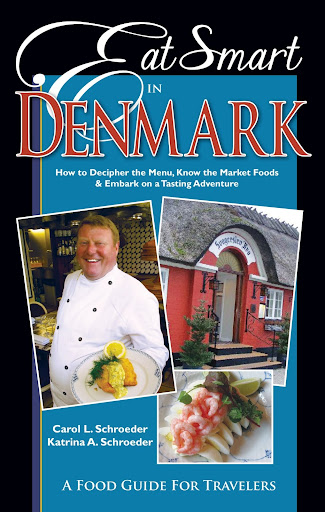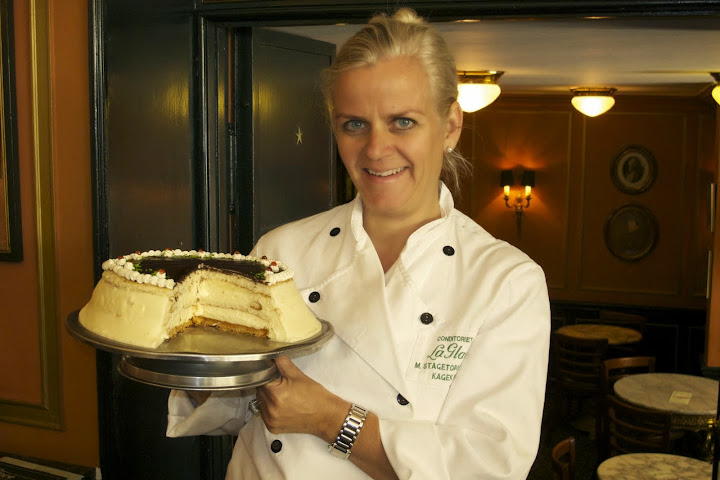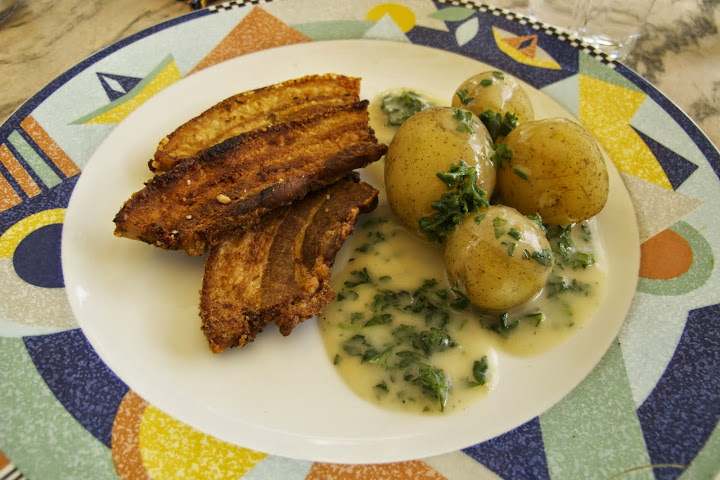Denmark, although small, plays a large role in the world. Why, you may ask? Well, among many things (Vikings, Brahe, HC Anderson, Kierkegaard, Kronborg Castle of Hamlet fame), the food. Oh, the food. My aunt has traveled to Denmark for many years, and always comes back with food gifts - and food stories. It might also be our northern European heritage, but any time (any time!) we have a chance to eat Danish food, we're on it.
So imagine my delight when my favorite publisher, Joan Peterson of Ginkgo Press (home to the many Eat Smart Guides we've reviewed here, including Sicily, Germany, and France), contacted me about her newest publication - Eat Smart in Denmark: How to decipher the menu, know the market foods, and embark on a tasting adventure. Oh, joy - books I love, from a cuisine I'd love to learn more about.

Here's the thing I love about Eat Smart Guides - they are for the thinking traveler. If you love history, language, culture, cuisine, markets, and recipes, this is your series. They have it all, from a foodie's history to a dictionary of words you'll need to know. And somehow, Peterson finds authors that are just as interested in places and people and food as we are - if not MORE SO. For Eat Smart in Denmark, you'll find that authors Carol L. Schroeder and her daughter, Katrina A. Schroeder, are the perfect experts and guides for this culinary journey. They have a long background in Denmark and Danish food - which you'll soon discover, as you dig into this book. And if you're in Madison, Wisconsin, stop by Orange Tree Imports and say hi.
The book is divided into these delicious chapters:
- The cuisine of Denmark
- Regional Danish food
- Tastes of Denmark
- Shopping in Denmark's food markets
- Resources
- Helpful phrases
- Menu guide
- Food and flavors guide
- Food establishments
- and a Great bibliography and index
Here's what you'll glean from digging in to Eat Smart in Denmark: a wonderful history of Denmark (including food!), restaurants, food and cultural traditions, and RECIPES!!! Don't worry - the authors have shared some of their favorite recipes after the interview. I learned so much - and have been making and enoying smørrebrød the last few days in celebration of the book! I also love learning about the people of Denmark, and how food is such an important part of the culture. To that, I say, let's go! I highly, highly recommend this book - it's a treasure.
But we're not in Denmark yet. So we were lucky enough to catch up with the authors, in between book promotions and Kringle competitions, and ask about the backstory of the book, inspiration, research, culture, and more. Here's what Katrina and Carol had to say...
Please tell us about your book, Eat Smart in Denmark...
Our book is a guide for anyone interested in food and Denmark.
Whether you've been there and loved the food, or are just planning your first trip and want to know what to expect, there is something for everyone. The recipes are delicious, the menu guide is comprehensive, and you'll learn about things you never knew you needed to know - like the intricacies of ordering a Danish hot dog from a street vendor.

What is your background in Denmark and Danish food?
My mom was in high school in a small town in New Jersey when a Danish exchange student came to town. They became fast friends, bonding over their scouting uniforms. She spent the summer before her senior year of high school with Annette's family in Denmark, then majored in Danish at Tufts University, spending her junior year studying at the University of Copenhagen before getting her Masters in Scandinavian Studies from UW Madison.
She instilled her love of Denmark and Danish food into both me and my brother. I first got a degree in publishing, then became a registered dietitian, so the combination of writing about Denmark and food was a natural for me.
Research, research, research - what were some of the joys and challenges of researching this book?
We absolutely loved the eating part of the research, as well as traveling around Denmark talking with local chefs and food experts. Any excuse for the two of us to spend some time traveling together is always fun. It was also exciting to take lots of color photographs for the book, and we caused a bit of a stir in restaurants with our cameras and reflector.
There were of course some challenges, though. My mom is fluent in Danish, but I don't speak the language, so the interviews needed to be conducted in English. This also made some of the research harder for me to do. (Believe it or not there are not a lot of English books published about the history or regional specialties of Danish food!)
What are your favorite Danish recipes - and foods?
We both really enjoy the recipe in our book for red cabbage. It's a Christmas specialty in Denmark and just the smell of it cooking is enough to put you into a warm, cozy mindset. The taste is a little sweet from the apple, and a bit sour from the vinegar, and of course the color is very vibrant. The recipe for Viking fish soup is another favorite, in part because it is so basic and you can just picture the Vikings throwing all of the ingredients into a big pot after a long day of conquering!
We also both love Danish pastries. There is one that roughly translates to poppy seed roll, which is a flaky dough with almond paste and poppy seeds. But we wanted all of the recipes in our book to be accessible to the American home cook, so there are not many pastries or other complicated recipes - though not for lack of trying! We had help testing a recipe for the grand Othello Cake from Conditori La Glace in Copenhagen, but we just could not get it to turn out correctly using American ingredients. Must be something special in the air in Denmark!

How does the Danish propensity for celebrations - and coziness - influence their cuisine?
This is hard to describe, as anyone who has attempted to translate the word hygge knows. Family is very important, and they don't go out to eat nearly as often as Americans do. So family celebrations are often in the home, centered around home-cooked meals made with fresh, local ingredients. If that doesn't sound cozy, I don't know what does!
What is most surprising about Danish food and culture?
One thing that I think people find surprising is that their traditional dishes do not shy away from the use of fat (lots of bacon, fried pork, cream in sauces, butter, etc). However, Danish people are generally considered very healthy. There are likely several reasons for this, including portion sizes and physical activity. It's important to remember to enjoy the delicacies there in moderation, and rent a bike! Another thing that I continue to find surprising is their love of very strong black licorice. Each time I visit I think: this will be the year that I will understand the appeal of licorice. And no matter how I try, I just don't like it. My mom gave up on that one a long time ago.

What's up next for you both?
We had our book launch in New York City last month at a restaurant called The Copenhagen and were thrilled that the Consul General of Denmark attended. He had wonderful things to say about the book and about Danish food in general. We're having a party in Madison, WI this month that will include the North American Kringle competition, complete with a custom-made kringle frozen custard and tastings of a kringle-flavored liquor. After that we're off to Denmark to celebrate the book's release with our friends there in October. Then it's back to "normal" life! Carol runs a gift shop in Madison, WI with my dad and I counsel adolescents on nutrition issues at Boston Children's Hospital.
Is there anything else you'd like to share with us?
You may not be familiar with Danish food (although you may have come across New Nordic Cuisine, which is based on traditional dishes from Denmark and the rest of Scandinavia), but it's never too late to get acquainted with the food, the country, and the people. We think you'll love it as much as we do!
Here are 2 of our favorite recipes:
Rødkål
Pickled red cabbage. Makes about 4 cups.
Pickled red cabbage is very popular in Denmark, served with pork or frikadeller either cold as a garnish on smørrebrød, or warm as a side dish at dinner. It is sometimes prepared using ribssaft or ribsgele (red currant juice or jelly) or æblemost (apple juice). This recipe, which features apple slices, is from the Danish-Canadian Marcus Schioler.
1 medium head red cabbage
1 small white onion
3 tablespoons butter
3 tablespoons sugar
3 tablespoons white or cider vinegar
pinch of thyme
2 bay leaves
¼ cup water
4 apples (Granny Smith are best), cored, peeled, and sliced thinly
salt and pepper to taste
Remove and discard outer leaves of cabbage, then cut cabbage into quarters and remove the white core. Thinly slice the cabbage with a chef's knife across the quarters widthwise. Peel and thinly slice the onion.
Melt the butter over medium heat in a large Dutch oven. Mix in the sugar.Add the cabbage and onion and stir to coat with butter. Add water, vinegar, thyme, and bay leaves. Heat to a boil, cover, and then simmer for 30 minutes. Add apples to the cabbage, plus a little salt and pepper.
Continue simmering for about 1 hour, stirring occasionally and adding a bit of water as necessary. The cabbage shouldn't be allowed to get too dry; there should always be a bit of liquid at the bottom of the pot. When done, the apples should be the consistency of purée and the cabbage tender.
Generally, the taste of rødkål is even better the day after cooking.
Viking Fiskesuppe
Viking fish soup. Serves 6–8.
This recipe from a thousand years ago comes to us courtesy of the Ribe VikingeCenter on the west coast of Jutland. Although the ingredient list specifies trout, the Vikings would sometimes have used cod, mackerel, or flat fish such as plaice, flounder, or dab. Fish and shellfish were an important source of protein for the Vikings, especially in coastal areas, and were either eaten fresh, or preserved by smoking, salting, or drying.
2 tablespoons butter
5 onions, diced
5 carrots, diced
10 cups water
1 handful (about 1 cup) chopped chervil*
1 handful (about 1 cup) chopped garden cress
1 cup finely chopped spring onion
(scallion)
1 cup heavy cream
2 pounds trout or other whitefish, cut into bite-sized pieces
salt to taste
Melt the butter in a large pot. Add the onions and carrots and sauté for 2–3 minutes. Add the water and bring to a boil. Leave to simmer until the vegetables are cooked al dente, then add the chervil, cress, spring onion, and cream.
Add the fish to the soup. Simmer over low heat until the fish is cooked and tender, approximately 5 minutes. Season to taste with salt and serve with bread.
*Parsley may be substituted.
Learn more at:
http://www.eatsmartguides.com/
Photos: Author photo courtesy and copyright Alex Smith, all others taken by Carol and Katrina Schroeder
Recipes courtesy and copyright Carol and Katrina Schroeder
Note: We received a review copy of Eat Smart in Denmark from Ginkgo Press - thank you!
